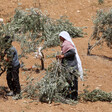The Electronic Intifada Podcast 19 October 2024
Abed had been writing about an Israeli attack in the vicinity of the Al-Aqsa Martyrs Hospital in the central area, which engulfed tents in flames, burning people alive.
One teen, Shaaban al-Dalou, died alongside his mother, Alaa. In a horrifying video of their murder seen around the world, they were engulfed in flames, a result of the Israeli attack.
Alaa’s charred body was identified by the necklace around her neck, Abed reported on the program after speaking to a relative. Al-Dalou’s brother later succumbed to wounds he sustained during the attack.
Abed recalled a young girl he would see on his visits to the hospital who also perished in the massacre. “I never imagined that I would see her burning alive,” he said.Deliberate starvation
But Israel’s continuing bombardment of schools, homes and hospitals are not the only means by which it is killing Palestinians in Gaza. Israel’s deliberate policy of starvation is causing death and intense suffering throughout the coastal enclave.
“There’s nothing in the markets, there’s nothing to buy, there are no vegetables,” Abed, who is in central Gaza, told EI’s Ali Abunimah and Nora Barrows-Friedman.
But the situation is particularly dire in the north.
This week, the Associated Press reported rather matter of factly that Israeli Prime Minister Benjamin Netanyahu “is examining a plan to seal off humanitarian aid to northern Gaza in an attempt to starve out Hamas militants, a plan that, if implemented, could trap without food or water hundreds of thousands of Palestinians unwilling or unable to leave their homes.”
Any Palestinians remaining in northern Gaza – a large area including Gaza City – “would be considered combatants – meaning military regulations would allow troops to kill them – and denied food, water, medicine and fuel.”
But that intensified genocide-by-starvation plan had already been well underway. On Saturday, the United Nations World Food Programme said that no food aid has entered northern Gaza since 1 October.
“People have run out of ways to cope, food systems have collapsed and the risk of famine is real,” Antoine Renard, WFP country director for Palestine, said.
In reality, Palestinians in northern Gaza, particularly children, have been starving to death for months as the direct result of Israel’s declared policy of cutting off all life-sustaining supplies to the territory.
Yet while Israel is open about its intentions, it could not carry out this mass-murder by starvation without the aid and support of the United States – which still purports to be working towards getting more aid into Gaza.
This was at the heart of a recent episode of Al Jazeera’s flagship documentary series Fault Lines. “Starving Gaza” – a 25-minute film – shows how the United States government has been knowingly covering up for Israel as it deliberately starves Palestinians to death.
The film features an interview with Stacey Gilbert, an official who resigned from the State Department in May after witnessing how the US government falsified a report to cover up its knowledge that Israel is deliberately preventing aid from entering Gaza.
As Gilbert explains, these lies were necessary from the perspective of the US administration, because admitting the truth would trigger an obligation under US law to stop sending weapons to Israel.
“The determination that Israel is not blocking humanitarian assistance is patently, demonstrably false,” Gilbert said.
We were joined by Emmy and Peabody award-winning journalist Laila Al-Arian, the executive producer of the program.
“At the time that we were editing and putting together this film, there’s an estimate that 38 people had died of starvation in Gaza, all but one were children,” Al-Arian told the livestream.
“I’m certain this is an undercount. I think far more people have died of starvation than was documented, because some people are dying of starvation in their homes.”
Targeting journalists
Two parents were hesitant to continue filming after their son, 5-month old Abdelaziz, died of complications from starvation during filming.
“There’s a sense of almost like moral duty and obligation in Palestinians to tell their stories under the most horrific circumstances,” Al-Arian explained.
“I think people are also starting to question: why should we tell our stories? Nothing is changing. The world sees our pain and our suffering, and they’re continuing the starvation policy,” she added.
The same applies to Palestinian journalists in the Strip, where Israel has murdered 177 media workers to date.
“That simply doesn’t resonate, or doesn’t seem to resonate with my journalistic colleagues, especially in the United States and Europe and elsewhere,” Al-Arian said.
“In legacy newsrooms, you will see signs: I stand with Evan [Gershkovich],” Al-Arian said of the American journalist for The Wall Street Journal who was detained by Russian authorities on espionage charges (He was freed in a US-Russian prisoner exchange in August).
“You will see signs about Austin Tice,” she added of the veteran US Marine Corps officer turned freelance journalist who disappeared in Syria.
“You won’t see Shireen Abu Akleh, you won’t see the 176 journalists killed,” Al-Arian said, attributing this to a lack of a “depth of feeling” for Palestinians, despite Abu Akleh – the world renowned Al Jazeera correspondent murdered by an Israeli sniper in 2022 – being a US citizen.
The lies of 7 October
Last week, we marked the first anniversary of the start of Israel’s genocide in Gaza, which followed the Palestinian resistance operation that routed the Israeli army’s Gaza Division in mere hours.
Associate editor Asa Winstanley and Abunimah spoke about the latest reporting on Israel’s wide scale application of the Hannibal Directive on 7 October 2023 – the order that allows its forces to kill Israeli citizens to stop them being taken captive.
Winstanley concluded in his most recent article that Israel had likely killed hundreds of its own people that day.
Barrows-Friedman provided a new briefing at the top of the show with all the latest news headlines from Gaza, the occupied West Bank and Lebanon.
She also highlighted recent dispatches written by our contributors in Gaza and published exclusively on The Electronic Intifada.
Armed resistance to invasion
Contributing editor Jon Elmer covered the latest resistance news in Gaza, from the southernmost area of the coastal enclave in Rafah, all the way to the north.
Using videos published by the armed wings of resistance organizations in Gaza and curated by Elmer, he analyzed their latest operations against invading Israeli soldiers.
This includes an operation by the Qassam Brigades, the armed wing of Hamas, against a group of Israeli soldiers in Rafah.
The fighters targeted a berm created by Israeli soldiers, using a 20-kilogram, explosive-laden drone. Footage shows soldiers standing in the open, what Elmer called “tactical obliviousness.”
“Do you just stand up at the top of your berm so that every person in the Gaza Strip could see that you’re there?” he asked.
“And they pay the price for it. These guys pay the price for the stupidity.”
The Qassam Brigades also carried out a complex ambush as part of their ongoing defense of Jabaliya, in northern Gaza.
And Elmer detailed how Lebanese resistance organization Hizballah conducted a drone strike on a base of the Golani Brigade, an elite division of the Israeli military, deep inside Israel.
The attack killed at least four Israeli soldiers, and injured dozens more.
Hizballah “hit at dinner time to maximize the strike deep inside Israel, hitting behind the lines in Lebanon with a significant psychological blow,” Elmer said.
You can watch the program on YouTube, Rumble or Twitter/X, or you can listen to it on your preferred podcast platform.
This writer produced and directed the program and The Electronic Intifada’s Maureen Clare Murphy and Asa Winstanley contributed writing and production. Michael F. Brown pre-production assistance and Eli Gerzon contributed post-production assistance.
Past episodes of The Electronic Intifada livestream can be viewed on our YouTube channel.





Comments
Jon Elmer videos of resistance
Permalink Erin Wade replied on
I somehow got on twitter but I can't seem to figure it out. I'm sorry to bother you, Jon, about this minor matter, but i really want to know. When the Resistance & I am not sure which group shows photos of their messaging while setting up their weapons, I have been seeing a big red inverted triangle with Arabic written across the top on a black background. Just wanted to let you know that if you sold T-shirts with that picture, I would buy one, or something wearable with that picture. It makes me feel proud of all that the resistance is doing to protect the people of Gaza against complete and utter barbarism, especially as the US is getting much more directly involved, as I alternate between rage and tears. Thank you for your work.